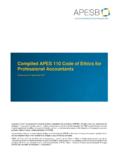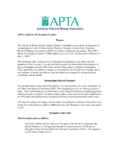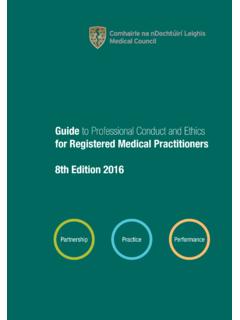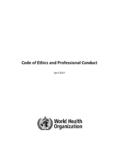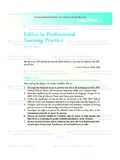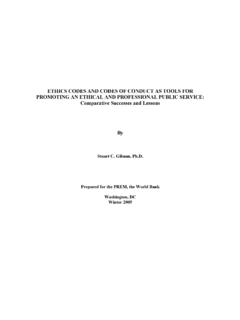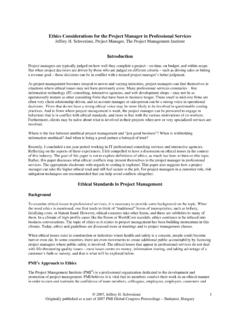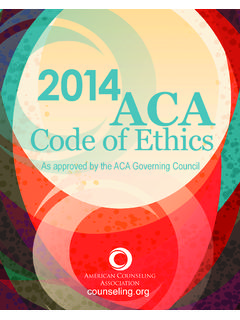Transcription of CFP Board Ethics and Professional Responsibility, …
1 CFP Board Ethics and Professional responsibility , rules of Conduct and Financial Planning Practice Standards This Document Will Help You Prepare To Take The Online Examination A Center for Continuing Education 707 Whitlock Ave, SW, Suite C-27. Marietta, GA 30064. 770-702-7917 | 800-344-1921. Fax: 770-702-7914. Disclaimer: CFP Board 's Code of Ethics and Professional responsibility , rules of Conduct, Financial Planning Practice Standards, Fitness Standards for Candidates and Registrants and Anonymous Case Histories are the property of CFP Board and may not be resold, republished or copied without the prior consent of CFP Board .
2 Copyright Notice: Copyright 2016, Certified Financial Planner Board of Standards, Inc. All rights reserved. Reproduced with permission.. Table of Contents Course Introduction and Objectives .. 5 Terminology .. 6 Definitions and Terminology .. 6 Chapter 1: Code of Ethics and Professional responsibility .. 9 Principle 1 Integrity .. 9 Principle 2 Objectivity .. 10 Principle 3 Competence .. 10 Principle 4 Fairness .. 11 Principle 5 Confidentiality .. 11 Principle 6 11 Principle 7 Diligence .. 12 Chapter One Review Questions .. 13 Chapter 2: rules of Conduct .. 14 Six Categories of 14 Category 1.
3 Defining the Relationship with the Prospective Client or Client .. 14 Category 2. Information Disclosed To Prospective Clients and Clients .. 18 Category 3. Prospective Client and Client Information and Property .. 20 Category 4. Obligations to Prospective Clients and Clients .. 23 Category 5. Obligations To Employers .. 24 Category 6. Obligations to CFP Board .. 25 Chapter Two Review Questions .. 27 Chapter 3: Financial Planning Practice 28 Definition of the Financial Planning Process .. 29 The Financial Planning Process .. 29 When Does The Financial Planning Relationship Occur?
4 30 1. Establishing and Defining the Client/Planner Relationship .. 32 2. Gathering Client Data .. 32 3. Analyzing and Evaluating the Client's Information .. 33 4. Developing and Presenting the Financial Planning Recommendations .. 34 5. Implementing the Recommendations .. 36 6. Monitoring .. 36 Summary of Additional Responsibilities When Financial Planning Occurs .. 37 Chapter Three Review Questions .. 40 Course Introduction and Objectives The CFP Standards of Professional Conduct were adopted by the Certified Financial Planner Board of Standards, Inc. (CFP Board ) to provide principles and rules for candidates pursuing CFP Board designation as well as registrants and certificants.
5 The purpose of the Standards of Professional Conduct is to ensure all those pursuing, or those who have already attained a CFP certification recognize their responsibilities in upholding the strict standards required of CFP . professionals. A critical component of CFP certification includes continuing education (CE). A. minimum of 30 hours of CE are required to maintain an active CFP certification. Of the 30 required hours, a minimum of two hours are required to address the Standards of Professional Conduct. Upon completion of this comprehensive course, certificants should be able to: Define and discuss a financial planning engagement, material elements of financial planning, and the financial planning process.
6 Analyze specific fact patterns to determine if a financial planning relationship exists. Differentiate between the standards of care set forth in rules and of the rules of Conduct, and apply each standard of care to specific factual situations. Apply each Practice Standard set forth in the Financial Planning Practice Standards to a hypothetical financial planning engagement. Identify the information that must be disclosed to the client in writing by a CFP Professional who is engaged in a financial planning relationship or providing material elements of financial planning.
7 Define the required information that must be disclosed to clients and prospective clients, when that information must be disclosed, and apply each disclosure requirement to specific factual situations. (This includes but is not limited to the compensation and conflict-of-interest disclosure requirements set forth in Rule of the rules of Conduct and Practice Standards 100-1, 400-3, and 500-1.). 5. Copyright 1998-2016 Center for Continuing Education Terminology Definitions and Terminology The following definitions and terminology are used within the Code and in this course.
8 They are necessary to understand the Principles and rules discussed. These definitions are taken from the Code. CFP Board denotes Certified Financial Planner Board of Standards, Inc. Candidates for CFP Certification denotes candidates who have applied for the CFP . certification but have not completed all the necessary steps to receive it as required by CFP Board . Certificant denotes individuals who are currently certified by CFP Board . Certificant's Employer denotes any person or entity that employs a certificant or registrant to provide services to a third party on behalf of the employer, including certificants and registrants who are retained as independent contractors or agents.
9 Client denotes a person, persons, or entity who engages a certificant and for whom Professional services are rendered. Where the services of the certificant are provided to an entity (corporation, trust, partnership, estate, etc.), the client is the entity acting through its legally authorized representative. Commission denotes the compensation generated from a transaction involving a product or service and received by an agent or broker, usually calculated as a percentage on the amount of his or her sales or purchase transactions. This includes 12(b)1 fees, trailing commissions, surrender charges and contingent deferred sales charges.
10 Compensation is any non-trivial economic benefit, whether monetary or non- monetary, that a certificant or related party receives or is entitled to receive for providing Professional activities. 6. Copyright 1998-2016 Center for Continuing Education A conflict of interest exists when a certificant's financial, business, property and/or personal interests, relationships or circumstances reasonably may impair his/her ability to offer objective advice, recommendations or services. Fees-only. A certificant may describe his or her practice as fee-only if, and only if, all of the certificant's compensation from all of his or her client work comes exclusively from the clients in the form of fixed, flat, hourly, percentage or performance-based fees.

